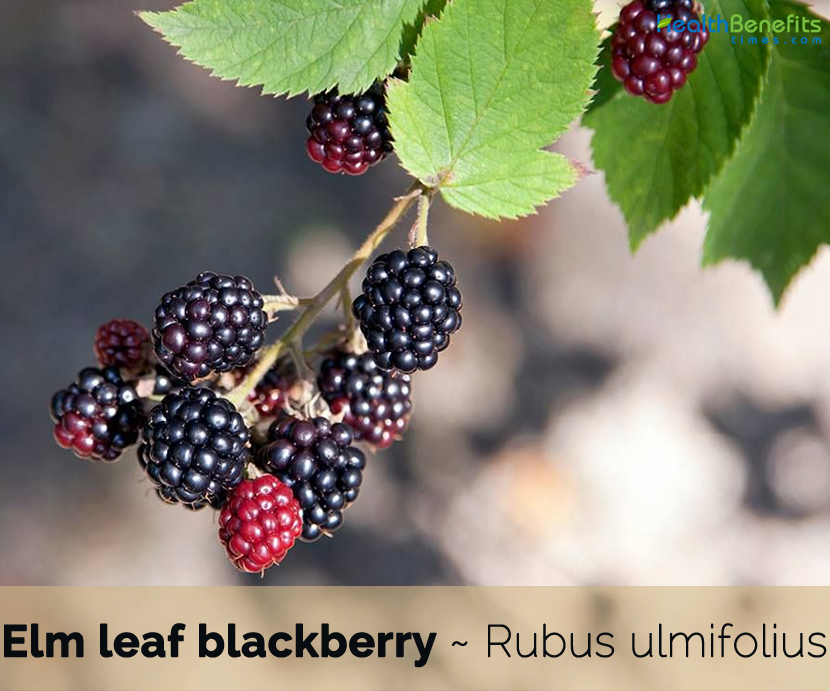| Elm leaf blackberry Quick Facts | |
|---|---|
| Name: | Elm leaf blackberry |
| Scientific Name: | Rubus ulmifolius |
| Origin | Western Europe, from the Netherlands south to Spain and Portugal, in Britain and Ireland, as well as NW Africa |
| Colors | Initially green, ripening red, maturing dark purple or almost black |
| Shapes | Head of little, one-seeded compound drupe |
| Taste | Sweet |
| Calories | 99 Kcal./cup |
| Major nutrients | Manganese (67.83%) Total dietary Fiber (30.26%) Copper (29.78%) Vitamin C (25.56%) Vitamin E (22.53%) |
| Health benefits | Beneficial for diarrhea, digestive ailments, healing wounds, fever, diabetes, hemorrhoids, and many other complaints |
Plant Description
Elm leaf blackberry is a brambly spreading semi-deciduous shrub that grows about 5 meters (almost 17 feet) tall, sometimes with spines but not always. The plant is found growing in forests, riparian habitats, freshwater wetlands, woodland garden sunny edge, dappled shade, shady edge, stream sides, near ways, hedges, borders of woods, agricultural areas, brambles, ravines, margins of meadows and forests, clearings of forests and banks. The plant prefers well-drained humid, acid or basic soils. Stems are low-arching and interlacing, distinctly whitish becoming reddish, sharply angled. Stems have few to many stout, erect to slightly hooked prickles on angles. Young stems are velvety.
Leaves
Primocane leaves are compound with 3 or 5 leaflets (sometimes some joined); mature mid leaflets densely and minutely felted below, pilose hairs absent or rare. Terminal leaflet is usually largest, 3–5.5 (rarely to 8) cm long and 1–3 (rarely to 5.5) cm wide, petiole is 2–6.5 cm long. Floricane leaves consist of 3 (or less often 5) leaflets (sometimes some joined), lower surface of mid floricane leaflets are similar to lower surface of mid primocane leaves, terminal leaflet are mostly 2.5–8 cm long and 2–5.5 cm wide, petiole is 2–5.5 cm long. Leaflets are green on the upper surface but white on the underside because of a dense layer of woolly hairs
Flower & Fruits
Inflorescence is a cylindrical terminal panicle of flowers. Sepals are long-pointed, velvety and with very few, longer, simple hairs, usually without but sometimes with prickles. Petals 8–15 mm long, 4–12 mm wide, broad elliptic to orbicular, usually pale pink, cup-shaped and often slightly crumpled. Stamens are equal in length to styles. Flowering normally takes place from July. Fertile flowers are followed by small head of little, one-seeded compound drupe. They are initially green, ripening red, maturing dark purple or almost black. They are soft, juicy, sweet and savory.
Despite their somewhat overpoweringly rapid adaptation to some climates, Elm leaf blackberries are a preferred fruit in numerous dishes worldwide. Their abundance in so many American, European and Asian countries has made it easier for fresh stocks of Elm leaf blackberries to be available in a great number of local markets, thus encouraging the consumption of the fruit. This is certainly the best way to guarantee a proper intake of vitamins and minerals and enjoy the wonderful health benefits this fruit has to offer.
- It is sometimes considered a food-medicine, at least in Spain and Portugal.
- Consumption of the boiled or raw young shoots, the raw fruits, and the wine prepared with them are considered good remedies to stop diarrhea.
- Liqueur of the fruits is also drunk against digestive ailments.
- The consumption of the young shoots is supposed to have a depurative effect and the jam to fight against iron deficiency.
- Other remedies against diarrhea, not so related with food use, are to drink the infusion or decoction of flowers, leaves, young shoots or fruits.
- It is also used against skin disorders, such as healing wounds, applying the raw leaves, the dried leaves powder, or the decoction of the bark.
- It has been also used against fever, diabetes, hemorrhoids, and many other complaints.
Culinary Uses
- Elm leaf Blackberries are highly appreciated fruits in many Mediterranean countries.
- They are usually eaten raw, both directly in the field and as a dessert when brought home, and also smashed with sugar, and used to prepare jams, jellies, and desserts.
- Elm leaf Blackberries are commonly used to elaborate beverages as well.
- Fruits are softened in liquor or anisette.
- They can be also smashed and mixed with wine and sugar to elaborate the so-called blackberry wine or with water and sugar to prepare a refreshing beverage.
- In the north of Portugal, Elm leaf blackberries were added to grape juice to improve the color and fermentation of wine, as grapes ripening is difficult in this region.
- The sour peeled young shoots are consumed as a vegetable in spring when they sprout.
- They are usually eaten raw in the field but can be also prepared in salads, boiled like asparagus, and included in omelets.
- Shoots and young leaves are sometimes used to elaborate liqueurs.
Other Facts
- Purple to dull blue dye is obtained from the fruit.
- Root yields an orange dye when mixed with salt.
- Bark is very flexible and was used for weaving baskets and tying brooms or many other things.
- In some localities the canes were used as fuel and the fruits for making writing ink.
- Though brambles are considered weeds since they propagate easily in pastures roads or walls and are difficult to eradicate, they are also welcome or even planted to form thorny hedges.
References:
https://www.itis.gov/servlet/SingleRpt/SingleRpt?search_topic=TSN&search_value=504890#null
https://davesgarden.com/guides/pf/go/210261/
http://www.hear.org/pier/species/rubus_ulmifolius.htm
https://npgsweb.ars-grin.gov/gringlobal/taxonomydetail.aspx?id=313548
https://pfaf.org/user/Plant.aspx?LatinName=Rubus+ulmifolius
http://www.floracatalana.net/rubus-ulmifolius-schott
https://plants.usda.gov/core/profile?symbol=RUUL
https://en.wikipedia.org/wiki/Rubus_ulmifolius
https://www.discoverlife.org/mp/20q?search=Rubus+ulmifolius
http://www.theplantlist.org/tpl1.1/record/rjp-12
https://ipfs.io/ipfs/QmXoypizjW3WknFiJnKLwHCnL72vedxjQkDDP1mXWo6uco/wiki/Rubus_ulmifolius.html
Comments
comments
